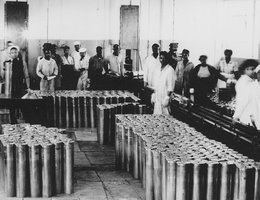

Before Pearl Harbor, rumors were flying that Nebraska communities would be chosen as sites for government defense plants. Due to the efforts of Nebraska’s congressmen and senators, Mead, Hastings, Grand Island, and Sidney became the locations for ammunition manufacturing plants and storage facilities.
These defense industries created thousands of jobs for Nebraskans and brought additional workers to the state. But they also created severe housing shortages. Many farm families, whose lands were bought at seemingly unfair prices, were displaced.
The largest ammunition depot in the nation was at Hastings. On June 10, 1942, the War Department approved the building of a $45-million naval ammunition depot southeast of Hastings. The site was chosen because it was halfway between the Atlantic and Pacific coasts.
It manufactured and stored bombs, mines, rockets, 40-millimeter shells, and six-inch shells. The Hastings Naval Ammunition Depot (NAD) supplied 40% of the Navy’s ammunition during the war.
Explosion was the biggest danger at the Hastings NAD. At least four major explosions occurred, killing 21 people. The first accident left a crater 550 feet long, 220 feet wide, and 50 feet deep. The blast caved in the roof on the Harvard, Nebraska, High School, 15 miles away. The blast was felt as far away as Omaha, almost 150 miles away.